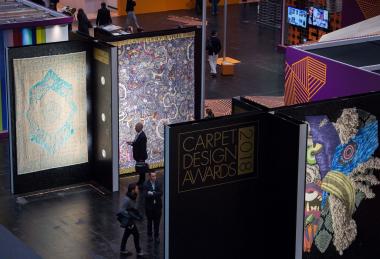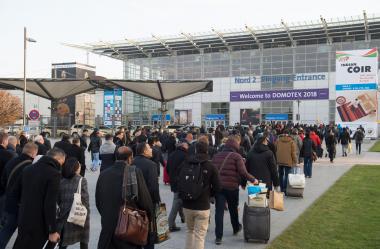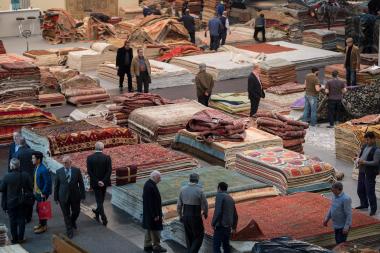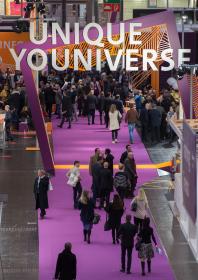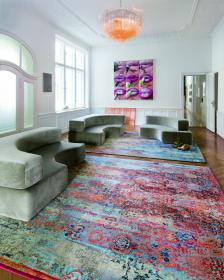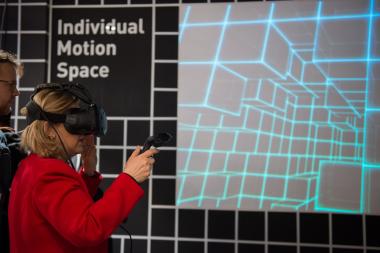GLOBAL FLOOR COVERINGS INDUSTRY ENTHUSIASTICALLY EMBRACES NEW DOMOTEX
- Record-breaking event in terms of exhibitor turnout and booked space
- Strong visitor turnout a clear signal that new concept is right on target
- New “Framing Trends” showcase a big hit among exhibitors and visitors alike
DOMOTEX 2018 featured a fresher, more modern, trendier look and feel than ever. Running from 12 to 15 January in Hannover, Germany, the event sported an all-new site and hall layout, plus a new Friday-to-Monday run and an array of immersive displays exploring the lead theme of UNIQUE YOUNIVERSE. This all added up to optimal visitor orientation and a fresh take on the world of floor coverings. As the world’s leading trade fair for carpets and floor coverings, DOMOTEX once again delivered top performance as a driver of new business, trends and innovations. 1,615 exhibitors and 45,000 trade visitors from over 100 nations traveled to Hannover to kick off an exciting year of business. The new DOMOTEX was enthusiastically received by the global floor coverings industry, which sported a record number of exhibitors and a record amount of booked space (106,000 square meters), thus underscoring a tangible turnaround in the floor coverings industry. “Significant growth in the number of participating exhibitors and the amount of booked space, a strong visitor turnout, an abundance of new products and innovations as well as an upbeat mood throughout the exhibition halls all bear witness to the great success of this year’s event”, commented Dr. Andreas Gruchow as the responsible member of Deutsche Messe’s Managing Board at the close of the event. “With UNIQUE YOUNIVERSE as this year’s chosen keynote theme, DOMOTEX provided a brightly lit stage for the individualization trend and all the inspiration and innovation associated with it, thus enhancing the show’s image as a prime source of orientation on interior furnishing and lifestyle trends.”
“Framing Trends” showcase provided a huge source of inspiration
The special “Framing Trends” showcase in Hall 9 was where visitors could most fully experience the significance of “UNIQUE YOUNIVERSE” as the exhibition’s keynote theme. Exhibitors, young designers and artists used Framing Trends to explore the topic of individuality in 20 different “framed” rooms. This special display proved hugely popular among attendees and offered a wealth of inspiration. “Framing Trends was a big success. Its fresh approach gave rise to lots of new ideas and made DOMOTEX more attractive than ever,” remarked Gruchow. “This special showcase will therefore also be a key offering at future editions of DOMOTEX,” he added.
A visit to Framing Trends was particularly high on the agenda of architects, designers and planners, who used this creative hotspot to gather new inspiration for their work – all the more so since Framing Trends covered the full spectrum of floor covering products. “‘Framing Trends’ in Hall 9 attractively featured and summarized everything on offer at DOMOTEX. With its fresh approach and central location, it served as the beating heart of the show and proved especially appealing to architects, interior designers and designers,” commented Chris Middleton, an architect at KINZO based in Berlin.
Highly international mix of attendees
More than 65 percent of the event’s 45,000 visitors came from abroad – around 60 percent of them coming from Europe, with some 25 percent from Asia and 11 percent from the Americas. Attendance from the United States and South and Central America increased. The majority of DOMOTEX visitors were buyers from specialist retailers and wholesalers as well as architects and interior designers and workers from the skilled trades. A strong increase in attendance was particularly evident among home furnishing and furniture stores, architects, interior designers, contract floorers and skilled tradesmen. As usual, DOMOTEX visitors once again demonstrated a high degree of decision-making authority.
Visitors were delighted at the many innovations on display. “SÜDBUND takes part in DOMOTEX every year. This time we organized our first-ever delegation trip to DOMOTEX for our members. We’re thrilled about all the inspiration we were able to gather, including insight into the latest floor covering advancements and trends. It’s already clear to us that we’ll be back with an even larger delegation in 2019,” said Michael Kovac, Purchasing Manager for Floor Coverings & Accessories at SÜDBUND – the Purchasing Association for Home Textiles based in Backnang, Germany).
Strong contributions by architects and designers
The rich supporting program of talks and presentations on the keynote theme provided further inspiration, and met with a very enthusiastic response on the part of exhibitors and visitors alike. Among the featured speakers were such renowned architects as Werner Aisslinger (Studio Aisslinger, Berlin), Andreas Krawczyk (NKBAK, Frankfurt/Main), Chris Middleton (KINZO, Berlin) and Jürgen Mayer H. (J.MAYER.H and Partners, Berlin). Intriguing architecture and design projects were presented and discussed, covering everything from initial conceptualization to the design process and on to production and sales strategies. Daily guided tours led by big-name architects and designers such as Peter Ippolito (Ippolito Fleitz Group, Stuttgart), Jürgen Mayer. H. (J.MAYER.H and Partners, Berlin) and Susanne Schmidhuber (SCHMIDHUBER, Munich) gave visitors special insight into products and the show’s keynote theme while putting them in direct touch with exhibitors of particular interest to them.
The talks given by the internationally acclaimed interior design blogger and author Holly Becker from Decor8 also met with very enthusiastic audiences. Becker explained how DOMOTEX exhibitors could collaborate with bloggers to raise the market profile of their products. Together with other well-known bloggers, she also delved into the topic of tomorrow’s furnishing trends. The use of virtual reality as an interior design tool was an equally exciting topic in Hall 9, where many visitors donned virtual reality glasses to experience the many possible uses and benefits of this new technology.
Further inspiration was provided by the “Art Day Workshops” staged within the context of Framing Trends by Canadian design firm Creative Matters. Participants were invited to experiment with colors, coal, tint and wax on paper to create fresh new designs pertaining to the keynote theme, UNIQUE YOUNIVERSE. At the so-called floorCODES WorkLabs held by the Institute of International Trend Scouting (of the University of Applied Research and Art, Hildesheim, Germany), participants had an opportunity to apply the institute’s “IIT HAWK” method to generate visionary scenarios for the future of floor coverings.
The presentation of the Carpet Design Awards on the Saturday of the show was another highlight in Hall 9. These internationally renowned awards were given in eight different categories, in recognition of the world's most beautiful handmade designer carpets. Also worthy of special mention is that Hall 13 established itself as a new magnet for parquet layers and other floor-laying professionals as well as interior decorators and painters, while the many Treffpunkt Handwerk offerings gave skilled tradespeople a valuable source of tips and tricks for their everyday work.
The next Hannover edition of DOMOTEX will be staged from 11 to 14 January 2019.
Starting in 2019, DOMOTEX will also be staged in North America. The debut of DOMOTEX USA will be from 28 February to 2 March 2019 at the Georgia World Congress Center in Atlanta, Georgia.
Deutsche Messe


